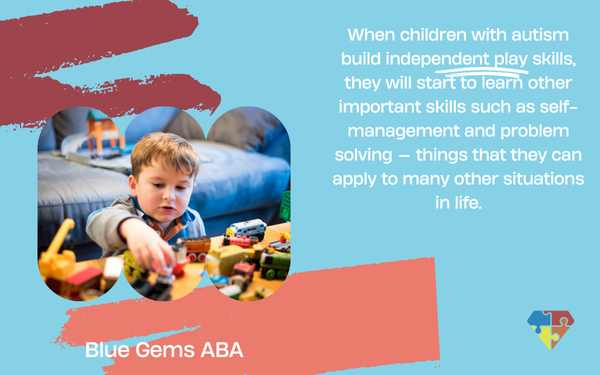Why is Independent Play Encouraged in ABA?
Children who have autism spectrum disorder (ASD) commonly face struggles with communication and social interaction. Because of this, it might seem odd to say that it’s important to encourage children with autism to play independently.
After all, independent play is done alone and doesn’t require a child to interact and/or communicate with others at all. So, wouldn’t encouraging independent play be like ignoring the skills that they need to build?
While children with autism certainly need extra support so they can learn social interaction skills, it’s equally as important for them to learn how to play on their own. Not only is independent play good for parents — as it gives them the opportunity to tend to other things for themselves and their family — it’s also very beneficial for the children themselves.
In this article, we’ll discuss the importance of teaching independent play for children with ASD, as well as how applied behavior analysis, or ABA therapy, can help do so.
Table Of Contents
Why is Independent Play Important for Children with Autism?
It may seem counterintuitive to encourage children with autism to play independently. After all, many children on the autism spectrum face challenges when it comes to interacting with others and, as a result, may prefer to be by themselves because of anxiety they feel or because they get overwhelmed easily.
This form of being alone, though, isn’t a positive. It’s not that children are choosing to play independently in these situations, but rather that they are separating themselves from others because of internal challenges they face.
In addition, when children with autism avoid social interactions with peers, for instance, they may flock to people with whom they’re familiar and comfortable. This could result in them becoming “clingy” to their parents.
Encouraging independent play is important because it teaches children with autism how they can occupy their own time in an enjoyable way without needing others to be directly involved. These skills can help them build confidence and independence, as they aren’t as reliant on someone else.
When children with autism build independent play skills, they will start to learn other important skills such as self-management and problem solving — things that they can apply to many other situations in life.

And, at the same time, when children with autism learn to play independently, it frees up their parents, caregivers and others to do the things that they need to do in life.
What Skills Do Children with Autism Need to Master to Play Independently?
Independent play skills may seem like they would come naturally to children, but that’s not necessarily true, especially for children with autism. Instead, children with ASD often have to be taught some of the individual components of independent play before they’re able to play on their own.
Some of these components include being able to sit alone and remain there for periods of time, attending to some activity until they complete it, not engaging any behaviors that are self-injurious and/or dangerous while they’re alone, understanding simple instructions including “sit down” or “come here,” engaging in different activities to keep them occupied, and being able to communicate that they need help or are finished.
These are all key components of mastering independent play, and must be taught first before children with autism can be expected to play on their own.
| Skill Area | Why It Matters | How ABA Teaches It |
|---|---|---|
| Sitting Alone | Foundation of independent play | Gradual reinforcement, prompts |
| Task Completion | Builds focus and follow-through | Small steps, rewards |
| Safety Awareness | Prevents harmful behaviors | Monitoring, reinforcement |
| Instruction Following | Enables guidance during play | Visual + verbal cues |
| Communication | Helps express needs | Communication systems, modeling |
How Does ABA Therapy Teach Independent Play to Children with Autism?
ABA therapy will start teaching independent play to children with autism by assessing the child’s level of mastery of each of the key components, identifying the areas of need and support. This will allow the therapy team to create a plan to target each of these components and skills.
Then, the therapists will follow some of the core principles and strategies of ABA therapy to teach these skills. This includes breaking down skills into manageable steps, using prompts, accompanying verbal instructions with visual aids and incorporating a rewards system to positively reinforce the skills they have successfully completed.
ABA therapists may also use social stories to help teach these skills and even model some of the skills themselves. This can provide your child with a blueprint that they can mimic as they start to learn the skills necessary to master independent play.
Blue Gems ABA Helps Children with ASD Learn Essential Play Skills
All forms of play are very important for children to master, which is why teaching play skills is an essential component of ABA therapy. Independent play is also important, as it teaches children with ASD much-needed skills while also building their self-confidence and independence.
At Blue Gems ABA, we help children with autism learn the essential play skills that they can carry with them throughout their life. By tailoring all of our treatment plans to each individual child’s unique strengths, challenges and preferences, we are better able to help support children with ASD so they can live as independently as possible.
To learn more, please contact us today.




